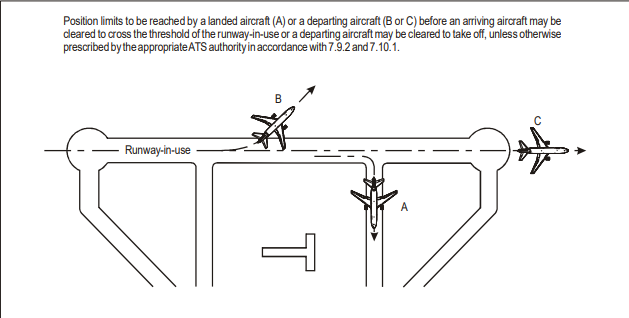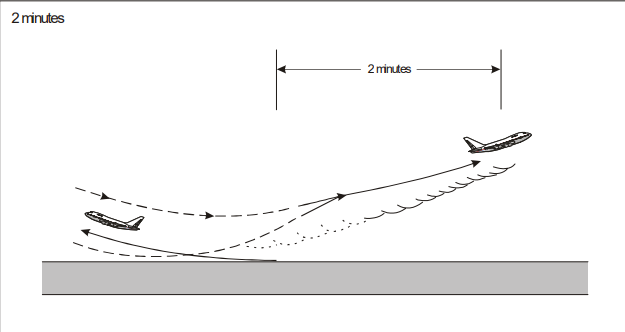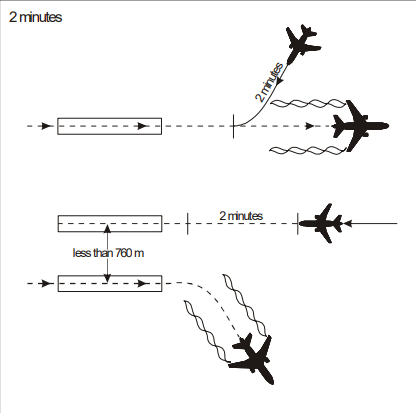Runway Separation
Only one aircraft may occupy a runway at a time. Takeoff or landing clearance must not be issued if another aircraft is occupying the runway unless specific conditions allow otherwise.
A departing aircraft will not normally be cleared for takeoff until:
- The preceding departing aircraft has crossed the end of the runway-in-use or has started a turn.
- All preceding landing aircraft are clear of the runway-in-use.
- Takeoff clearance may be issued when there is reasonable assurance that prescribed separation will exist at the time of departure.
- If an ATC clearance is required before takeoff, it must be transmitted and acknowledged before issuing the takeoff clearance.
- The takeoff clearance must be issued when the aircraft is ready for departure and at or approaching the departure runway. The runway designator must be included to avoid misinterpretation.
- An immediate takeoff clearance may be issued before the aircraft enters the runway, requiring the aircraft to taxi onto the runway and depart in one continuous movement.
A landing aircraft will not normally be permitted to cross the runway threshold unless:
- The preceding departing aircraft has crossed the end of the runway-in-use or started a turn.
- All preceding landing aircraft are clear of the runway-in-use.
To expedite traffic, a landing aircraft may be instructed to:
- Hold short of an intersecting runway after landing.
- Land beyond the touchdown zone. (Not applicable to HEAVY aircraft.)
- Vacate the runway at a specified exit taxiway.
- Expedite vacating the runway.
Controllers must consider aircraft type, runway length, exit locations, braking action reports, and weather conditions when issuing such instructions. If a pilot is unable to comply, they must inform ATC immediately.
When necessary, such as in low visibility, an aircraft may be instructed to report when it has vacated the runway. The report must be made after the entire aircraft is beyond the relevant runway-holding position.
Reduced runway separation
Reduced Runway Separation (RRS) can only be applied if the following conditions are met:
- Tailwind component does not exceed 5 knots
- Visibility is at least 5 km and the ceiling is 1,000 ft (300 m) or higher
- Wake turbulence separation is maintained at all times
- Braking action is not significantly impaired by precipitation
- On VATSIM, braking is considered impaired by snow (SN), snow grains (SG), ice grains (PL), hail (GR), and rime (GS)
- Rain (RA) and drizzle (DZ) do not affect RRS
- The following aircraft in the RRS sequence must receive traffic information about the preceding aircraft
RRS can only be applied during daylight hours, from 30 minutes after sunrise to 30 minutes before sunset.
Aircraft Categories
For RRS, aircraft are divided into three categories based on size and type:
| Category | Aircraft Type | Examples |
|---|---|---|
| Category 1 | Single-engine propeller aircraft, max takeoff weight ≤ 2,000 kg | C152, C172, P28A, A210, DA40, DR40, DV20, SR22 |
| Category 2 | Single-engine propeller aircraft (2,000 – 7,000 kg) and twin-engine propeller aircraft (≤ 7,000 kg) | DA62, PA34, TBM9, BE58, B350 |
| Category 3 | All other aircraft | AT75, DH8D, C25C, CRJ9, B738, A359 |
Departure Behind Departure
The following departure must receive traffic information about the leading departure. If all conditions are met, the second departure may be cleared for takeoff as soon as the first departure has taken off and is a defined distance ahead.
| Preceding Aircraft | Succeeding Aircraft | Minimum Distance After Takeoff |
|---|---|---|
| Category 1 or 2 | Category 1 | 600 m |
| Category 1 or 2 | Category 2 | 1,500 m |
| Category 3 | Any Aircraft | 2,400 m |
Example:
A DV20 (Cat 1) IFR departs first, followed by a BE58 (Cat 2) VFR. Normally, the second aircraft would have to wait until the DV20 passes the end of the runway. Under RRS, the BE58 can be cleared for takeoff as soon as the DV20 is airborne and at least 1,500 m ahead. This improves runway efficiency.
Arrival Behind Arrival
The second approach must receive traffic information about the first approach. If all conditions are met, the second approach may be cleared for landing before the preceding aircraft has vacated, provided the first aircraft keeps moving and does not backtrack.
| Preceding Aircraft | Succeeding Aircraft | Minimum Distance After Landing |
|---|---|---|
| Category 1 or 2 | Category 1 | 600 m and moving toward an exit without backtracking |
| Category 1 or 2 | Category 2 | 1,500 m and moving toward an exit without backtracking |
| Category 3 | Any Aircraft | 2,400 m and moving toward an exit without backtracking |
Example:
A C172 (Cat 1) IFR lands first, followed by a TBM9 (Cat 2) IFR. Normally, the TBM9 would have to wait until the C172 clears the runway. Under RRS, the TBM9 can be cleared to land as soon as the C172 has passed 1,500 m beyond the threshold and is still moving toward an exit.
Arrival Behind Departure
The arriving aircraft receives traffic information about the departure. If all conditions are met, the landing clearance may be issued once the departing aircraft is airborne and past the defined distance.
| Preceding Departure | Succeeding Arrival | Minimum Distance Past Threshold |
|---|---|---|
| Category 1 or 2 | Category 1 | 600 m |
| Category 1 or 2 | Category 2 | 1,500 m |
| Category 3 | Any Aircraft | 2,400 m |
Example:
A DA40 (Cat 1) departs, followed by a B350 (Cat 2) arriving. Normally, the B350 would wait until the DA40 passes the end of the runway. Under RRS, the B350 can receive landing clearance as soon as the DA40 is airborne and at least 1,500 m past the threshold.
Departure Behind Arrival
RRS does not apply in this case. A departure must wait until a landing aircraft has completely vacated the runway.
| Scenario | Minimum Requirement for the Second Aircraft |
|---|---|
| Departure behind departure | First aircraft is airborne and has passed 600m (Cat 1), 1,500m (Cat 2), or 2,400m (Cat 3) ahead |
| Arrival behind arrival | First aircraft has landed and is still moving toward an exit, at least 600m (Cat 1), 1,500m (Cat 2), or 2,400m (Cat 3) past the threshold |
| Arrival behind departure | Departing aircraft is airborne and has passed 600m (Cat 1), 1,500m (Cat 2), or 2,400m (Cat 3) past the threshold |
| Departure behind arrival | RRS not applicable – standard separation required |
Intersecting runways
Many airports use intersecting runways to accommodate varying wind conditions or maximize efficiency in limited space. Proper separation procedures must be followed to ensure safe operations.
Departure Following a Departure
When two aircraft are departing from intersecting runways, the second aircraft may only begin its takeoff roll if one of the following conditions is met:
- The first aircraft has taken off and initiated a turn that ensures safe separation, or
- The first aircraft has completely crossed the intersection.
Departure Following an Arrival
If a landing aircraft is on the intersecting runway, the departing aircraft may only begin its takeoff roll when:
- The landing aircraft has fully vacated the runway, or
- The landing aircraft has stopped before the intersection as instructed and completed its landing roll, or
- The landing aircraft has crossed the intersection.
Arrival Following a Departure
If an arriving aircraft is following a departing aircraft on an intersecting runway, the arriving aircraft may only cross the runway threshold when:
- The departing aircraft has taken off and initiated a turn that maintains separation, or
- The departing aircraft has completely crossed the intersection.
Arrival Following an Arrival
For two landing aircraft on intersecting runways, the second aircraft may only cross the runway threshold if:
- The first aircraft has vacated the runway, or
- The first aircraft has stopped before the intersection as instructed and completed its landing roll, or
- The first aircraft has crossed the intersection.
Simultaneous landings on intersecting runways are only permitted under the following conditions:
- One of the intersecting runways must have at least 2200 meters of available distance between the threshold and the intersection.
- Additional conditions must be met:
- Visual Meteorological Conditions (VMC) must exist.
- Braking action must not be negatively affected.
- Both aircraft must be informed of the simultaneous landings.
- The aircraft landing on the 2200m runway must stop before the intersection as instructed.
| Scenario | Condition for Second Aircraft to Proceed |
|---|---|
| Departure following a departure | First aircraft has either crossed the intersection or initiated a turn. |
| Departure following an arrival | Landing aircraft has vacated the runway, stopped before the intersection, or crossed the intersection. |
| Arrival following a departure | Departing aircraft has crossed the intersection or initiated a turn. |
| Arrival following an arrival | First arriving aircraft has vacated the runway, stopped before the intersection, or crossed the intersection. |
Opposite direction
When an aircraft departs in the opposite direction, the following aircraft may only commence takeoff when:
- The preceding aircraft has crossed the point where the following aircraft will start its takeoff roll.
Additionally, a minimum separation of 2 minutes must be applied when:
- A LIGHT or MEDIUM aircraft follows a HEAVY aircraft.
- A LIGHT aircraft follows a MEDIUM aircraft that is making a low or missed approach.
These rules apply to:
- Takeoffs from opposite-direction runways.
- Landings on the same runway in the opposite direction or on a parallel opposite-direction runway separated by less than 760m (2,500 ft).
Two-minute wake turbulence separation for opposite-direction take-off:
Two-minute wake turbulence separation for opposite-direction landing:



